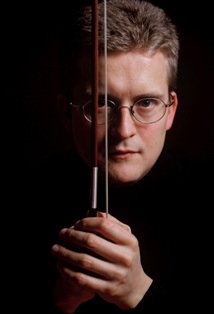
Tetzlaff's Bach Phenomenal
(first published in The Cincinnati Post Oct. 11, 2004)

The Chicago marathon was in progress as violinist Christian Tetzlaff left the windy city Sunday to fly to Cincinnati
Having caused a "seismic jolt" the three nights preceding (Chicago Tribune on his performance of Bartok’s Violin Concerto No. 2 with the Chicago Symphony led by guest conductor Paavo Järvi), the extraordinary fiddler came to Cincinnati for a marathon of his own, the complete sonatas and partitas for unaccompanied violin by J.S. Bach.
Presented in honor of the 75th anniversary of the Cincinnati Chamber Music Society, the concert began at 4 p.m. at Memorial Hall and, counting two fifteen-minute intermissions and a break for dinner, lasted until after 8 p.m.
Performed completely from memory, it was one of the most impressive and musically rewarding events this reviewer has experienced in two decades covering classical music in Cincinnati.
The German born violinist, who studied at the University of Cincinnati College-Conservatory of Music from 1985 to 1986, is a musical intelligence of the highest order. He possesses a genuineness of manner, also, that speaks directly to his listeners. Genial but not flamboyant, he sways a bit and rises up on his toes now and then. Eyes closed, he draws his bow to a tapered stop, making a slight turn to the audience with perhaps a little lift at the end of a movement. Nothing gets in the way of the music. The roar that greeted him at the conclusion of the Partita No. 3 was his listeners' helpless response to his art.
The set comprises three four-movement sonatas, alternating with three partitas (baroque dance suites) of various duration and character. Each sonata contains a fugue whose implied counterpoint Tetzlaff carved out precisely with supple motions of his bow. There were moments of blazing virtuosity in the Presto of Sonata No. 1, Gigue of Partita No. 2 and Preludio of Partita No. 3, where his playing sent up showers of sparks, and his broken chords in Tempo di Borea of Partita No. 1 mimicked an entire string orchestra.
Tetzlaff created a moment of supreme beauty in the Andante of Sonata No. 2, his encore in Chicago Saturday night and a rival of the famous "Air for the G String" from Bach’s Suite for Orchestra No. 3.
The cycle built to a climax with the great Chaconne that concludes Partita No. 2. Here, through double-stopping and broken chords, Tetzlaff drew a big, organ-like sound from his 2001 Peter Greiner violin.
The energy, cheer and sheer melodic interest of the final Partita brought the remarkable concert to a close. Repeatedly called back, Tetzlaff smiled but (understandably) declined an encore.